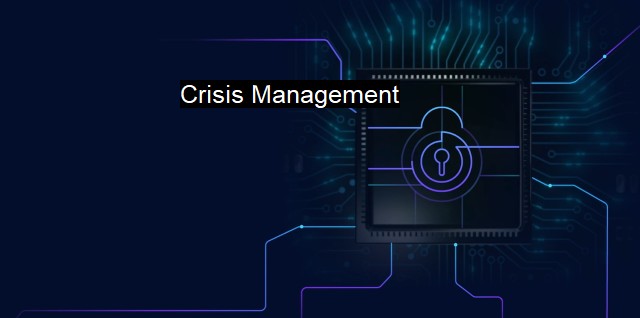What is Crisis Management?
Crisis Management for Cybersecurity and Antivirus: Strategies to Protect Digital Assets and Intellectual Property in Today's Digital Era.
Crisis management in the context of cybersecurity and antivirus refers to the process of identifying, assessing and handling security breaches, cyber-attacks, or threats to the technical infrastructure, intellectual property, and digital assets of an organization. Cybersecurity crisis management has become a critical process in today's digital era with the increasing incidents of cyber-attacks and the growing amount of sensitive data being stored and transmitted digitally.There are three key stages in a cybersecurity crisis management framework: preparation, response and recovery.
1. Preparation
Preparation involves identifying potential cyber threats and risks, assessing their potential impact on business operations and implementing appropriate mitigation strategies to minimize risks. The first step in preparing for a potential cybersecurity incident is to identify the scenarios that could lead to a cyber crisis.
Next, organizations need to ensure that they have the necessary technical infrastructure, policies, and procedures in place to detect, prevent and respond to potential cybersecurity incidents. Some of the key preparation activities include:
- Conducting regular security assessments to identify potential vulnerabilities in the networks, applications, and IT infrastructure.
- Developing and testing an incident response plan which outlines the process, roles, and responsibilities of different team members in responding to a cybersecurity incident.
- Creating a communication plan that outlines how different stakeholders will be informed in the event of a cybersecurity crisis.
2. Response
If a cybersecurity incident occurs, it’s important that organizations act quickly to contain the threat and prevent additional damage to systems and processes. During the response phase, organizations:
- Activate the incident response plan and initiate an investigation to identify what has happened and how it has impacted the organization.
- Contain the threat by isolating affected systems and limiting access to sensitive data.
- Triaging issues as they arise, ensuring the appropriate teams are engaged and aligning to the tactical goals of an incident response
- Identify the source of the issue and patch vulnerabilities to prevent it from happening again in the future.
3. Recovery
Once the cybersecurity incident has been brought under control and forensic analyses can begin, the organization should embark on the recovery phase. The recovery phase focuses on restoring key IT systems as quickly as possible and minimizing business disruptions. The recovery phase involves activities such as:
- Restoring affected systems and data, verifying all has been recovered properly
- Verifying that all due diligence has been performed, all regulatory or e-discovery obligations have been satisfied and lessons learned encapsulated in technical and non-technical revisions with subsequent system changes.
Cybersecurity crisis management is a crucial aspect of ensuring business continuity in the digital space. Organizations must be vigilant about uncovering potential network vulnerabilities, regularly perform assessments, and place preventative measures in position- priming them to act quickly, should an attack occur and with appropriate escalation plans seamlessly seeing incidents through to tactical endpoint restoration. Speed and skill in a crisis are keys to mitigate the treacherous aftermath of debilitating recovery activities; Cybersecurity crisis management experiences are essential in developing these skills, eventually leading to improved security, confidence and position of the business in their respective markets.

Crisis Management FAQs
How important is crisis management in cybersecurity and antivirus?
Crisis management is critical in cybersecurity and antivirus, especially as cyberattacks are becoming increasingly sophisticated and frequent. Effective crisis management can help organizations detect, respond to, and recover from a security breach or cyber attack while minimizing damages.What are the key steps involved in crisis management for cybersecurity and antivirus?
The key steps involved in crisis management for cybersecurity and antivirus include preparedness, response, recovery, and evaluation. Preparedness involves identifying and prioritizing threats, developing incident response plans, and ensuring that the necessary resources and personnel are available. Response involves implementing the incident response plan, containing the damage, and mitigating further risks. Recovery involves restoring systems and data, addressing any vulnerabilities, and learning from the incident. Evaluation involves reviewing and updating incident response plans and processes based on lessons learned from past incidents.What are some common challenges faced in crisis management for cybersecurity and antivirus?
Some common challenges faced in crisis management for cybersecurity and antivirus include limited resources, lack of awareness or understanding of security risks, complexity of technology and systems, and difficulties in maintaining compliance with regulations and standards. Additionally, the constantly evolving nature of security threats and attacks requires continuous vigilance and adaptation.How can organizations improve their crisis management capabilities for cybersecurity and antivirus?
Organizations can improve their crisis management capabilities for cybersecurity and antivirus by investing in cybersecurity training and awareness programs for employees, regularly testing and updating incident response plans, conducting vulnerability assessments and penetration testing, and implementing security controls and best practices based on industry standards and guidelines. Additionally, collaborating with external partners such as cybersecurity experts, law enforcement agencies, and other stakeholders can help strengthen crisis management capabilities. External Resources
| | A | | | B | | | C | | | D | | | E | | | F | | | G | | | H | | | I | | | J | | | K | | | L | | | M | |
| | N | | | O | | | P | | | Q | | | R | | | S | | | T | | | U | | | V | | | W | | | X | | | Y | | | Z | |
| | 1 | | | 2 | | | 3 | | | 4 | | | 7 | | | 8 | | |||||||